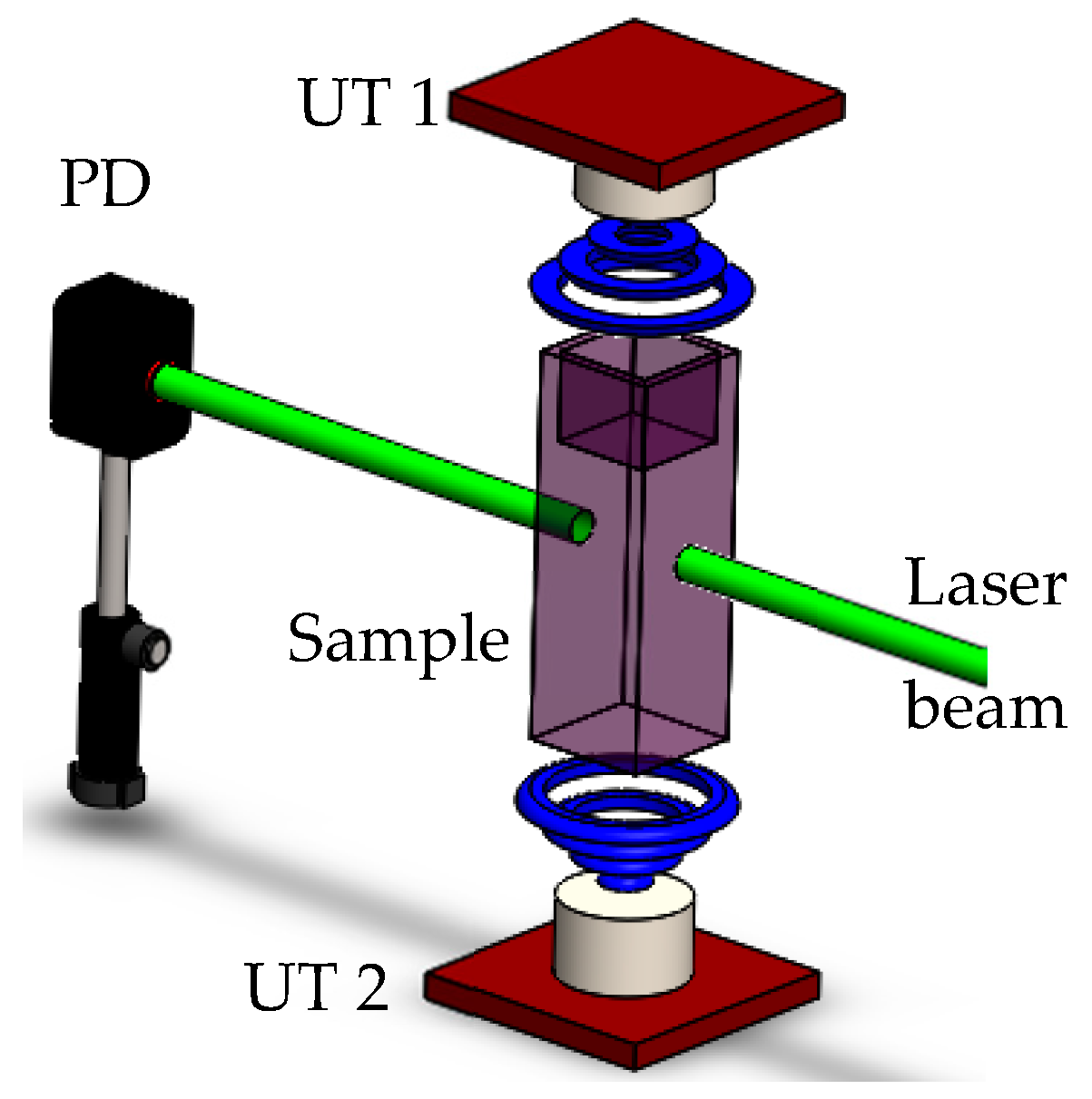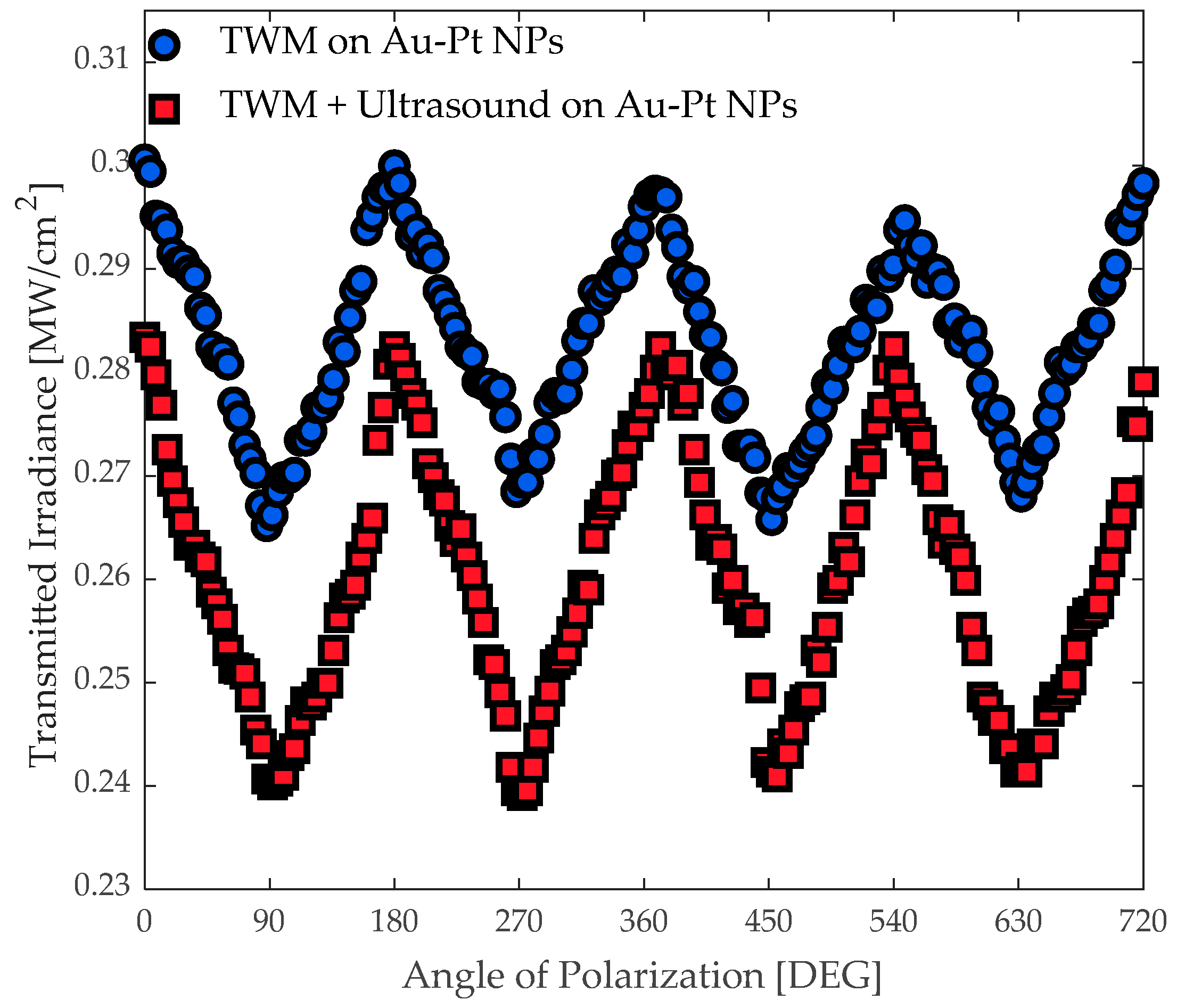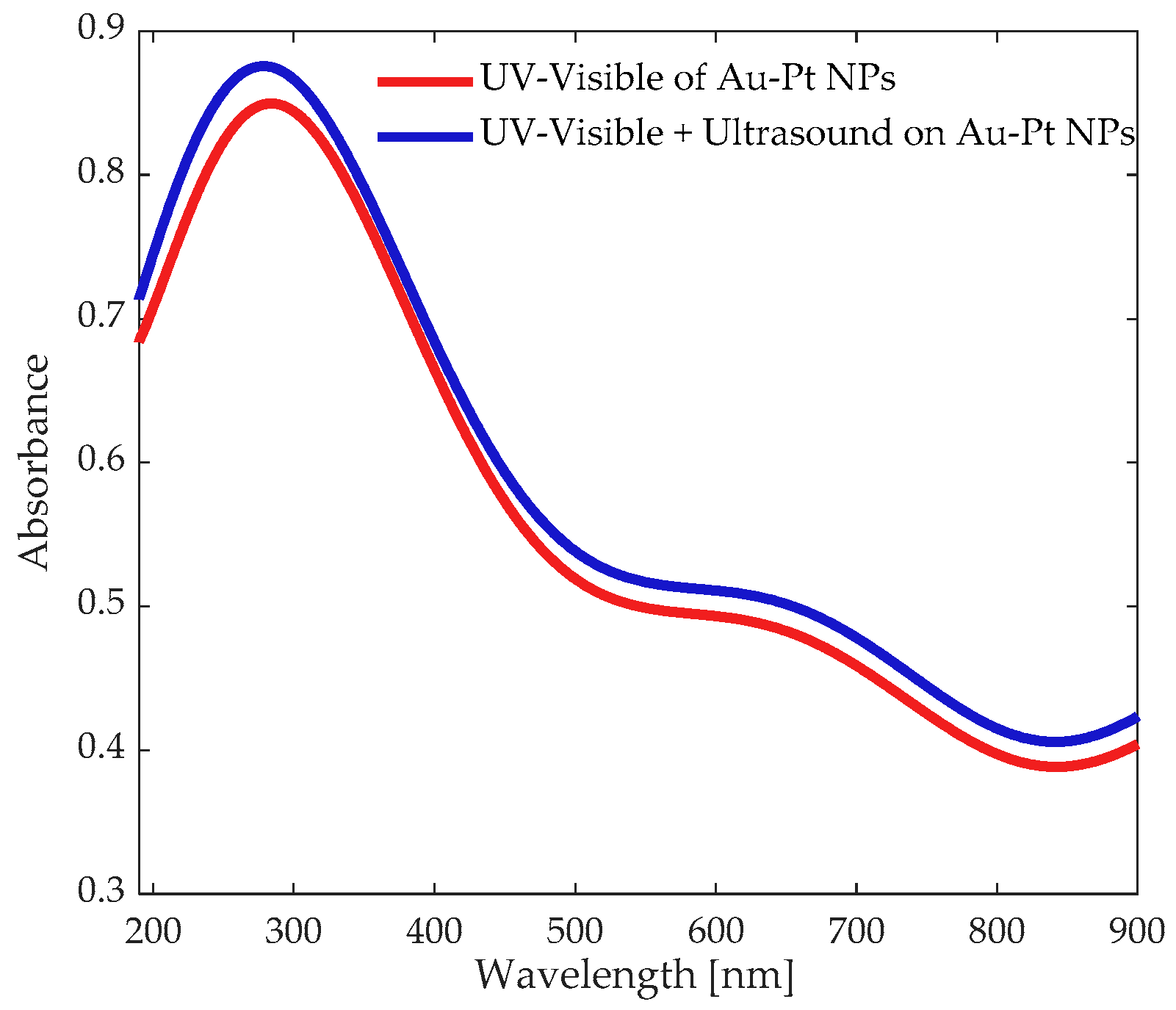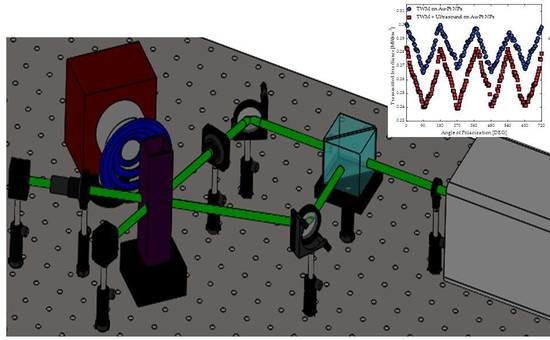Ultrasonic Influence on Plasmonic Effects Exhibited by Photoactive Bimetallic Au-Pt Nanoparticles Suspended in Ethanol
Abstract
1. Introduction
2. Materials and Methods
2.1. Sample Synthesis
2.2. Morphology Characterization
2.3. Nanosecond Optical Single-Beam Transmittance
2.4. Acousto-Optic Explorations
2.5. Two-Wave Mixing Experiment Influenced by US
2.6. Modulation of Plasmonic Signals by Ultrasonic Effects
3. Results
3.1. Characterization of the Synthesized Au-Pt NPs: TEM and EDX
3.2. Single-Beam Transmittance Measurements Affected by Ultrasonic Vibrations
3.3. TWM Measurements Affected by Ultrasonic Vibrations
3.4. Ultrasonically-Controlled Plasmonic Signals by Bimetallic Au-Pt Nanoparticles Suspended in Ethanol
4. Conclusions
Author Contributions
Funding
Acknowledgments
Conflicts of Interest
References
- Huang, D.; Zheng, C.; Huang, L.; Xiukai, W.; Ling, C. Linear and nonlinear optical properties of ultrafine WO3 nanorods. Optik 2018, 156, 994–998. [Google Scholar] [CrossRef]
- Etminan, M.; Hajiesmaeilbaigi, F.; Koohian, A.; Motamedi, A.; Golian, Y. Nonlinear optical properties of pulsed laser deposited Cu and Zn single and double layer nanostructure thin films. Thin Solid Films 2016, 615, 1–7. [Google Scholar] [CrossRef]
- Dai, H.; Zhang, L.; Wang, Z.; Wang, X.; Zhang, J.; Gong, H.; Han, J.-B.; Han, Y. Linear and nonlinear optical properties of silver-coated gold nanorods. J. Phys. Chem. C 2017, 121, 12358–12364. [Google Scholar] [CrossRef]
- Türk, M.; Erkey, C. Synthesis of supported nanoparticles in supercritical fluids by supercritical fluid reactive deposition: Current state, further perspectives and needs. J. Supercrit. Fluids 2018, 134, 176–183. [Google Scholar] [CrossRef]
- Pfeiffer, C.; Rehbock, C.; Hühn, D.; Carrillo-Carrion, C.; de Aberasturi, D.J.; Merk, V.; Barcikowski, S.; Parak, W.J. Interaction of colloidal nanoparticles with their local environment: The (ionic) nanoenvironment around nanoparticles is different from bulk and determines the physico-chemical properties of the nanoparticles. J. R. Soc. Interface 2014, 11, 20130931. [Google Scholar] [CrossRef]
- Cordeiro, M.; Ferreira, C.F.; Pedrosa, P.; Lopez, A.; Baptista, P.V. Gold Nanoparticles for Diagnostics: Advances towards Points of Care. Diagnostics 2016, 6, 43. [Google Scholar] [CrossRef]
- Karimzadeh, R.; Mansour, N. The effect of concentration on the thermo-optical properties of colloidal silver nanoparticles. Opt. Laser Technol. 2010, 42, 783–789. [Google Scholar] [CrossRef]
- Han, J.; Freyman, M.C.; Feigenbaum, E.; Han, T.Y.J. Electro-optical device with tunable transparency using colloidal core/shell nanoparticles. ACS Photonics 2018, 5, 1343–1350. [Google Scholar] [CrossRef]
- Gargiulo, J.; Violi, I.L.; Cerrota, S.; Chvátal, L.; Cortés, E.; Perassi, E.M.; Diaz, F.; Zemánek, P.; Stefani, F.D. Accuracy and Mechanistic Details of Optical Printing of Single Au and Ag Nanoparticles. ACS Nano 2017, 11, 9678–9688. [Google Scholar] [CrossRef]
- He, W.; Wu, X.; Liu, J.; Hu, X.; Zhang, K.; Hou, S.; Zhou, W.; Xie, S. Design of AgM Bimetallic Alloy Nanostructures (M = Au, Pd, Pt) with Tunable Morphology and Peroxidase-Like Activity. Chem. Mater. 2010, 22, 2988–2994. [Google Scholar] [CrossRef]
- Li, C.-H.; Li, M.-C.; Liu, S.-P.; Jamison, A.C.; Lee, D.; Lee, T.R.; Lee, T.-C. Plasmonically Enhanced Photocatalytic Hydrogen Production from Water: The Critical Role of Tunable Surface Plasmon Resonance from Gold-Silver Nanoshells. ACS Appl. Mater. Interfaces 2016, 8, 9152–9161. [Google Scholar] [CrossRef]
- Piña-Díaz, A.J.; Trejo-Valdez, M.; Morales-Bonilla, S.; Torres-San Miguel, C.R.; Martínez-González, C.L.; Torres-Torres, C. Nonlinear mechano-optical transmittance controlled by a rotating TiO2 thin solid film with embedded bimetallic Au-Pt nanoparticles. J. Nanomat. 2017, 2017, 2918509. [Google Scholar] [CrossRef]
- Mahmood, A.; Shah, A.; Shahzad, S.; Aftab, S.; Latif-ur-Rahman, N.J.; Shaha, A.H. Monitoring of an Anti-Ulcer Drug Rabeprazole Using Au-Pt Bimetallic Alloy Nanoscale Electrochemical Sensor. J. Electrochem. Soc. 2017, 164, H413–H419. [Google Scholar] [CrossRef]
- Haldar, K.K.; Kundu, S.; Patra, A. Core-Size-Dependent Catalytic Properties of Bimetallic Au/Ag Core–Shell Nanoparticles. ACS Appl. Mater. Interfaces 2014, 6, 21946–21953. [Google Scholar] [CrossRef]
- Zhao, L.Y.; Thomas, J.F.; Heinig, N.F.; Abd-Ellah, M.; Wang, X.Y.; Leung, K.T. Au–Pt alloy nanocatalysts for electro-oxidation of methanol and their application for fast-response non-enzymatic alcohol sensing. J. Mater. Chem. C 2014, 2, 2707–2714. [Google Scholar] [CrossRef]
- Ye, W.; Yu, J.; Zhou, Y.; Gao, D.; Wang, D.; Wang, C.; Xue, D. Green synthesis of Pt–Au dendrimer-like nanoparticles supported on polydopamine-functionalized graphene and their high performance toward 4- nitrophenol reduction. Appl. Catal. B Environ. 2016, 181, 371–378. [Google Scholar] [CrossRef]
- Mistry, H.; Reske, R.; Strasser, P.; Cuenya, B.R. Size-dependent reactivity of gold-copper bimetallic nanoparticles during CO2 electroreduction. Catal. Today 2017, 288, 30–36. [Google Scholar] [CrossRef]
- Wang, S.; Kristian, N.; Jiang, S.; Wang, X. Controlled synthesis of dendritic Au@Pt core-shell nanomaterials for use as an effective fuel cell electrocatalyst. Nanotechnology 2009, 20, 025605. [Google Scholar] [CrossRef] [PubMed]
- Wang, W.; Zou, Y.; Yan, J.; Liu, J.; Chen, H.; Li, S.; Zhang, L. Ultrasensitive colorimetric immunoassay for hCG detection based on dual catalysis of Au@Pt core–shell nanoparticle functionalized by horseradish peroxidase. Spectrochim. Acta Part A 2018, 193, 102–108. [Google Scholar] [CrossRef]
- Hurtado-Aviles, E.A.; Torres, J.A.; Trejo-Valdez, M.; Romero-Ángeles, B.; Villalpando, I.; Torres-Torres, C. Amplitude-modulated acoustic waves by nonlinear optical signals in bimetallic Au-Pt nanoparticles and ethanol based nanofluids. J. Mol. Liq. 2018, 263, 288–293. [Google Scholar] [CrossRef]
- Carriles, R.; Schafer, D.N.; Sheetz, K.E.; Field, J.J.; Cisek, R.; Barzda, V.; Sylvester, A.W.; Squier, J.A. Invited review article: Imaging techniques for harmonic and multiphoton absorption fluorescence microscopy. Rev. Sci. Instrum. 2009, 80, 081101. [Google Scholar] [CrossRef] [PubMed]
- Bijeesh, M.M.; Shakhi, P.K.; Varier, G.K.; Nandakumar, P. Tuning the nonlinear optical absorption in Au/BaTiO3 nanocomposites with gold nanoparticle concentration. Opt. Laser Technol. 2018, 102, 207–212. [Google Scholar] [CrossRef]
- Torres-Torres, C.; Tamayo-Rivera, L.; Rangel-Rojo, R.; Torres-Martínez, R.; Silva-Pereyra, H.G.; Reyes-Esqueda, J.A.; Rodríguez-Fernández, L.; Crespo-Sosa, A.; Cheang-Wong, J.C.; Oliver, A. Ultrafast optical phase modulation with metallic nanoparticles in ion-implanted bilayer silica. Nanotechnology 2011, 22, 355710. [Google Scholar] [CrossRef] [PubMed]
- Badr, Y.; Mahmoud, M.A. Effect of PVA surrounding medium on ZnSe nanoparticles: Size, optical, and electrical properties. Spectrochim. Acta Part A 2006, 65, 584–590. [Google Scholar] [CrossRef] [PubMed]
- Eslamian, M. Excitation by acoustic vibration as an effective tool for improving the characteristics of the solution-processed coatings and thin films. Prog. Org. Coat. 2017, 113, 60–73. [Google Scholar] [CrossRef]
- Tripathy, S.; Marty, R.; Lin, V.K.; Teo, S.L.; Ye, E.; Arbouet, A.; Saviot, L.; Girard, C.; Han, M.Y.; Mlayah, A. Acousto-Plasmonic and Surface-Enhanced Raman Scattering Properties of Coupled Gold Nanospheres/Nanodisk Trimers. Nano Lett. 2011, 11, 431–437. [Google Scholar] [CrossRef] [PubMed]
- Collis, J.F.; Chakraborty, D.; Sader, J.E. Autonomous propulsion of nanorods trapped in an acoustic field. J. Fluid Mech. 2017, 825, 29–48. [Google Scholar] [CrossRef]
- McGraw-Hill. Concise Encyclopedia of Science & Technology, 5th ed.; McGraw-Hill Professional Publishing: New York, NY, USA, 2005; p. 18. [Google Scholar]
- Lerosey, G.; Fink, M. Acousto-optic imaging: Merging the best of two worlds. Nat. Photonics 2013, 7, 265–267. [Google Scholar] [CrossRef]
- Laude, V.; Belkhir, A.; Alabiad, A.F.; Addouche, M.; Benchabane, S.; Khelif, A.; Baida, F.I. Extraordinary nonlinear transmission modulation in a doubly resonant acousto-optical structure. Optica 2017, 4, 1245–1250. [Google Scholar] [CrossRef]
- Gunther, J.; Andersson-Engels, S. Review of current methods of acousto-optical tomography for biomedical applications. Front. Optoelectron. 2017, 10, 211–238. [Google Scholar] [CrossRef]
- Kauranen, M.; Zayats, A.V. Nonlinear plasmonics. Nat. Photonics 2012, 6, 737–748. [Google Scholar] [CrossRef]
- Panoiu, N.C.; Sha, W.E.I.; Lei, D.Y.; Li, G.-C. Nonlinear optics in plasmonic nanostructures. J. Optic. 2018, 20, 083001. [Google Scholar] [CrossRef]
- Valley, D.T.; Ferry, V.E.; Flannigan, D.J. Imaging Intra- and Interparticle Acousto-plasmonic Vibrational Dynamics with Ultrafast Electron Microscopy. Nano Lett. 2016, 16, 7302–7308. [Google Scholar] [CrossRef] [PubMed]
- O’Brien, K.; Lanzillotti-Kimura, N.D.; Rho, J.; Suchowski, H.; Yin, X.; Zhang, X. Ultrafast acousto-plasmonic control and sensing in complex nanostructures. Nat. Commun. 2014, 5, 5042. [Google Scholar] [CrossRef] [PubMed]
- Fabelinskii, I.L. Molecular Scattering of Light, 1st ed.; Springer: Berlin, Germany, 1968; pp. 81–85. [Google Scholar]
- Yakovlev, V.V.; Dickson, W.; Murphy, A.; McPhillips, J.; Pollard, R.J.; Podolskiy, V.A.; Zayats, A.V. Ultrasensitive Non-Resonant Detection of Ultrasound with Plasmonic Metamaterials. Adv. Mater. 2013, 25, 2351–2356. [Google Scholar] [CrossRef] [PubMed]
- Ou, J.-Y.; Plum, E.; Zhang, J.; Zheludev, N.I. Giant Nonlinearity of an Optically Reconfigurable Plasmonic Metamaterial. Adv. Mater. 2016, 28, 729–733. [Google Scholar] [CrossRef]
- Chau, Y.-F.C.; Wang, C.-K.; Shen, L.; Lim, C.M.; Chiang, H.-P.; Chao, C.-T.C.; Huang, H.J.; Lin, C.-T.; Kumara, N.T.R.N.; Voo, N.Y. Simultaneous realization of high sensing sensitivity and tunability in plasmonic nanostructures arrays. Sci. Rep. 2017, 7, 16817. [Google Scholar] [CrossRef] [PubMed]
- Bigall, N.C.; Parak, J.P.; Dorfs, D. Fluorescent, magnetic and plasmonic—Hybrid multifunctional colloidal nano objects. Nano Today 2012, 7, 282–296. [Google Scholar] [CrossRef]
- Dowran, M.; Kumar, A.; Lawrie, B.J.; Pooser, R.C.; Marino, A.M. Quantum-enhanced plasmonic sensing. Optica 2018, 5, 628–633. [Google Scholar] [CrossRef]
- Ahmed, D.; Peng, X.; Ozcelik, A.; Zheng, Y.; Huang, T.J. Acousto-plasmofluidics: Acoustic modulation of surface plasmon resonance in microfluidic systems. AIP Adv. 2015, 5, 097161. [Google Scholar] [CrossRef] [PubMed]
- Hurtado-Aviles, E.A.; Torres, J.A.; Trejo-Valdez, M.; Urriolagoitia-Sosa, G.; Villalpando, I.; Torres-Torres, C. Acousto-Plasmonic Sensing Assisted by Nonlinear Optical Interactions in Bimetallic Au-Pt Nanoparticles. Micromachines 2017, 8, 321. [Google Scholar] [CrossRef] [PubMed]
- Sonawane, R.S.; Dongare, M.K. Sol–gel synthesis of Au/TiO2 thin films for photocatalytic degradation of phenol in sunlight. J. Mol. Catal. Chem. 2006, 243, 68–79. [Google Scholar] [CrossRef]
- Boyd, R.W. Nonlinear Optics, 3rd ed.; Academic Press: New York, NY, USA, 2008. [Google Scholar]
- Moniri, S.; Reza Hantehzadeh, M.; Ghoranneviss, M.; Asadi Asadabad, M. Au-Pt alloy nanoparticles obtained by nanosecond laser irradiation of gold and platinum bulk targets in an ethylene glycol solution. Eur. Phys. J. Plus 2017, 132, 318. [Google Scholar] [CrossRef]
- Morales-Bonilla, S.; Torres-Torres, C.; Trejo-Valdez, M.; Torres-Torres, D.; Urriolagoitia-Sosa, G.; Hernández-Gómez, L.H.; Urriolagoitia-Calderón, G. Engineering the optical and mechanical properties exhibited by a titanium dioxide thin film with Au nanoparticles. Opt. Appl. 2013, 43, 651–661. [Google Scholar] [CrossRef]
- Karkare, M.M. Choice of precursor not affecting the size of anatase TiO2 nanoparticles but affecting morphology under broader view. Int. Nano Lett. 2014, 4, 111–118. [Google Scholar] [CrossRef]
- Miguez, M.L.; De Souza, T.G.B.; Barbano, E.C.; Zilio, S.C.; Misoguti, L. Measurement of third-order nonlinearities in selected solvents as a function of the pulse width. Opt. Express 2017, 25, 3553–3565. [Google Scholar] [CrossRef] [PubMed]
- Lea-Banks, H.; Teo, B.; Stride, E.; Coussios, C.C. The effect of particle density on ultrasound-mediated transport of nanoparticles. Phys. Med. Biol. 2016, 61, 7906. [Google Scholar] [CrossRef] [PubMed]
- Quan, C.; He, M.; He, C.; Huang, Y.; Zhu, L.; Yao, Z.; Xu, X.; Lu, C.; Xu, X. Transition from saturable absorption to reverse saturable absorption in MoTe2 nano-films with thickness and pump intensity. Appl. Surf. Sci. 2018, 457, 115–120. [Google Scholar] [CrossRef]
- Torre, R.; Sánta, I.; Righini, R. Pre-transitional effects in the liquid-plastic phase transition of p-terphenyl. Chem. Phys. Lett. 1993, 212, 90–95. [Google Scholar] [CrossRef]
- Fernández-Valdés, D.; Torres-Torres, C.; Martínez-González, C.L.; Trejo-Valdez, M.; Hernández-Gómez, L.H.; Torres-Martínez, R. Gyroscopic behavior exhibited by the optical Kerr effect in bimetallic Au-Pt nanoparticles suspended in ethanol. J. Nanopart. Res. 2016, 17, 204. [Google Scholar] [CrossRef]
- Yesilkoy, F.; Terborg, R.A.; Pello, J.; Belushkin, A.A.; Jahani, Y.; Pruneri, V.; Altug, H. Phase-sensitive plasmonic biosensor using a portable and large field-of-view interferometric microarray imager. Light Sci. Appl. 2018, 7, 17152. [Google Scholar] [CrossRef] [PubMed]
- Verdan, S.; Burato, G.; Coment, M.; Reinert, L.; Fuzellier, H. Structural changes of metallic surfaces induced by ultrasound. Ultrason. Sonochem. 2003, 10, 291–295. [Google Scholar] [CrossRef]
- Kollath, A.; Cherepanov, P.V.; Andreeva, D.V. Controllable manipulation of crystallinity and morphology of aluminium surfaces using highintensity ultrasound. Appl. Acoust. 2016, 103, 190–194. [Google Scholar] [CrossRef]
- Cheng, L.J.; Guo, L.J. Nanofluidic diodes. Chem. Soc. Rev. 2010, 39, 923–938. [Google Scholar] [CrossRef]
- Yan, Y.; Warren, S.C.; Fuller, P.; Grzybowski, B.A. Chemoelectronic circuits based on metal nanoparticles. Nat. Nanotechnol. 2016, 11, 603–608. [Google Scholar] [CrossRef] [PubMed]
- Lee, J.U.; Gipp, P.P.; Heller, C.M. Carbon nanotube p-n junction diodes. Appl. Phys. Lett. 2004, 85, 145–147. [Google Scholar] [CrossRef]
- Gulbahar, B.; Memisoglu, G. Graphene-based Acousto-optic Sensors with Vibrating Resonance Energy Transfer and Applications. In Two-Dimensional Materials for Photodetector; IntechOpen Book: London, UK, 2018; pp. 179–192. [Google Scholar]
- Becerril, D.; Batiz, H.; Pirruccio, G.; Noguez, C. Efficient Coupling to Plasmonic Multipole Resonances by Using a Multipolar Incident Field. ACS Photonics 2018, 5, 1404–1411. [Google Scholar] [CrossRef]
- Tan, T.; Xie, H.; Xie, J.; Ping, H.; Su, B.-L.; Wang, W.; Wang, H.; Munir, Z.A.; Fu, Z. Photo-Assisted Synthesis of Au@PtAu Core-Shell Nanoparticles with Controllable Surface Composition for Methanol Electrooxidation. J. Mater. Chem. A 2016, 4, 18983–18989. [Google Scholar] [CrossRef]
- Gowthaman, N.S.K.; Sinduja, B.; Shankar, S.; John, S.A. Displacement Reduction Routed Au-Pt Bimetallic Nanoparticles: A Highly Durable Electrocatalyst for Methanol Oxidation and Oxygen Reduction. Sustain. Energy Fuels 2018, 2, 1588–1599. [Google Scholar] [CrossRef]
- Mesch, M.; Metzger, B.; Hentschel, M.; Giessen, H. Nonlinear Plasmonic Sensing. Nano Lett. 2016, 16, 3155–3159. [Google Scholar] [CrossRef]
- Gérard, D.; Laude, V.; Sadani, B.; Khelif, A.; Labeke, D.V.; Guizal, B. Modulation of the extraordinary optical transmission by surface acoustic wave. Phys. Rev. B 2007, 76, 235427. [Google Scholar] [CrossRef]
- Ganeev, R.A.; Ryasnyanskii, A.I.; Kodirov, M.K.; Kamalov, S.R.; Usmanov, T. Nonlinear Optical Characteristics of Colloidal Solutions of Metals. Opt. Spectrosc. 2001, 90, 568–573. [Google Scholar] [CrossRef]
- Kedenburg, S.; Vieweg, M.; Gissibl, T.; Giessen, H. Linear refractive index and absorption measurements of nonlinear optical liquids in the visible and near-infrared spectral region. Opt. Mater. Express 2012, 2, 1588–1611. [Google Scholar] [CrossRef]
- Pei, Y.; Yao, F.; Ni, P.; Sun, X. Refractive index of silver nanoparticles dispersed in polyvinyl pyrrolidone nanocomposite. J. Mod. Opt. 2010, 57, 872–875. [Google Scholar] [CrossRef]









© 2019 by the authors. Licensee MDPI, Basel, Switzerland. This article is an open access article distributed under the terms and conditions of the Creative Commons Attribution (CC BY) license (http://creativecommons.org/licenses/by/4.0/).
Share and Cite
Hurtado-Aviles, E.A.; Torres, J.A.; Trejo-Valdez, M.; Torres-SanMiguel, C.R.; Villalpando, I.; Torres-Torres, C. Ultrasonic Influence on Plasmonic Effects Exhibited by Photoactive Bimetallic Au-Pt Nanoparticles Suspended in Ethanol. Materials 2019, 12, 1791. https://doi.org/10.3390/ma12111791
Hurtado-Aviles EA, Torres JA, Trejo-Valdez M, Torres-SanMiguel CR, Villalpando I, Torres-Torres C. Ultrasonic Influence on Plasmonic Effects Exhibited by Photoactive Bimetallic Au-Pt Nanoparticles Suspended in Ethanol. Materials. 2019; 12(11):1791. https://doi.org/10.3390/ma12111791
Chicago/Turabian StyleHurtado-Aviles, Eric Abraham, Jesús Alejandro Torres, Martín Trejo-Valdez, Christopher René Torres-SanMiguel, Isaela Villalpando, and Carlos Torres-Torres. 2019. "Ultrasonic Influence on Plasmonic Effects Exhibited by Photoactive Bimetallic Au-Pt Nanoparticles Suspended in Ethanol" Materials 12, no. 11: 1791. https://doi.org/10.3390/ma12111791
APA StyleHurtado-Aviles, E. A., Torres, J. A., Trejo-Valdez, M., Torres-SanMiguel, C. R., Villalpando, I., & Torres-Torres, C. (2019). Ultrasonic Influence on Plasmonic Effects Exhibited by Photoactive Bimetallic Au-Pt Nanoparticles Suspended in Ethanol. Materials, 12(11), 1791. https://doi.org/10.3390/ma12111791






